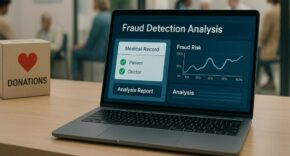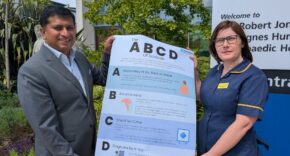The better use of digital technology has saved hundreds of people from sepsis in hospitals.
Across the country there has been a large effort to eradicate sepsis by implementing a one hour diagnosis and treatment for the condition. This new “alert and action” technology uses algorithms to read vital signs of patients and then alert medical professionals to the conditions that could lead to sepsis.
Sepsis is a life-threatening condition which happens when there is an infection in the body. The immune system in response to the infection damages organs and tissues. Sepsis is commonly known as blood poisoning.
There are currently 3 leading hospitals using this technology to identify sepsis and alert doctors when patients with the condition are getting worse. This is part is the NHS Long Term Plan.
Cambridge, Berkshire and Liverpool’s NHS leaders are assisting the rest of the health services learn how to utilise the tools to spot sepsis, which costs the lives of 37,000 livers annually, and is infamous for being hard to identify in its early stages.
In Liverpool 200 lives are saved each year by marrying patient observations and lab results into one place to help the medical staff diagnose and treat any suspected sepsis.
Deaths from sepsis have fallen considerably in Cambridge over the last 3 years. 64 lives have been saved in the past year from the innovative “alert and action” technology.
Screening rates have increased by 70% in Berkshire, since the Trust introduced the digital system. Previously, only 2 in 10 patients were screened from sepsis, but that number has increased to 9 in 10 patients who are consistently scanned during admission. This has allowed doctors to identify more cases sooner.
The implementation of this technology is part of a national effort to spread the use of technology across the NHS to help hospitals and patients alike.
National sepsis guidance has been made mandatory for all hospitals in England from this year. As part of this, hospital staff is obligated to inform senior doctors within an hour if sepsis patients don’t respond to treatment.
Celia Ingham Clark, medical director for clinical effectiveness at NHS England and NHS Improvement, said: “Sepsis is an extremely serious condition, but as part of the NHS Long Term Plan we have made huge improvements in spotting and treating it quickly, with more than nine in 10 people getting the checks they need.
“Now, with the help of innovative digital tools, the NHS is saving more lives by getting even better at identifying and treating sepsis.
“The systems at Liverpool, Cambridge and Berkshire are life-saving and as more hospitals adopt digital tools, thousands more families will be spared the harm and heartbreak of sepsis.”
Screening rates have increased from 78% in 2015 to 91% in 2018.
Dr Simon Eccles, chief clinical information officer at NHSX, said: “As an emergency medicine consultant, I know first-hand how helpful these technologies can be on a busy shift, to alert you to a deteriorating patient who might have sepsis and offering the best possible chance of saving their life.
“As we continue to deliver the NHS Long Term Plan, many parts of the country are using world class technology to save more lives and this programme is helping to ensure that learning is spread right across the NHS so others can benefit from their success.”
Dr Ron Daniels BEM, CEO of the UK Sepsis Trust, said: “Any kind of technology which assists clinicians in making prompt decisions when the warning signs of sepsis are detected should be embraced; with every hour that passes before the right antibiotics are administered the risk of death increases.
“The UK Sepsis Trust welcomes these initiatives, especially at such a time when the national spotlight is on the swift diagnosis and treatment of sepsis.
“These innovations involve technology that uses existing recognition strategies for sepsis. In the coming years, however, we expect that our improved understanding of the condition, combined with the embracing of evermore advancing technology, will ensure that we deliver the very best care to the patients who need it most urgently.”
Dr Paul Fitzsimmons, chief operating officer at The Royal Liverpool and Broadgreen University Hospitals NHS Trust, said: “We have seen a major impact on sepsis care with lives saved. In some cases, it would have been impossible to make a diagnosis of sepsis without the help of our digital system.
“By providing automated sepsis alerts from clinical information from multiple sources we are treating septic patients both faster and more effectively – helping our clinicians prioritise doing the right things first and reducing death rates in severe sepsis.”
Dr Afzal Chaudhry, renal consultant and chief clinical information officer at Cambridge University Hospitals NHS Foundation Trust, said: “Our ambition as a digital Trust is to use advanced technology to improve patient safety, provide high quality care and contribute to better outcomes.
“Our electronic sepsis alert and action feature, developed collaboratively by our clinicians and in-house digital team, better supports our doctors and nurses in being more aware of the possibility of sepsis and act quickly with appropriate treatment.
“It is an excellent example of how much of a difference digital technology can make to patient safety, care and outcomes.”
Mary Sherry, chief operating officer and deputy ceo at Royal Berkshire NHS Foundation Trust, said: “At the Royal Berkshire Hospital prior to implementation of the electronic screening process, all sepsis screening was completed on a paper screening tool contained within the medical and nursing admission booklet. Whilst the majority of patients had a screening tool started on admission, there was poor compliance with these being completed.
“A retrospective audit of usage also showed that patients were unlikely to have subsequent screening tools completed if there was clinical deterioration after their admission, meaning the capture rate of patients who developed sepsis in the trust was poor.
“Since implementation our compliance and treatment of potential and actual sepsis has continued to increase.”
Article Source: https://www.england.nhs.uk/2019/08/hundreds-of-lives-saved-through-new-tech-to-spot-sepsis/












